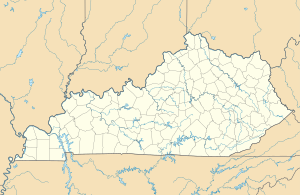Mayor Andrew Broaddus

Mayor Andrew Broaddus, a two story structure with elevated lookout tower
|
|
| History | |
|---|---|
| Name: | Mayor Andrew Broaddus |
| Launched: | 1929 |
| General characteristics | |
| Length: | 98 ft (30 m) |
| Beam: | 38 ft (12 m) |
| Depth: | 5 ft (1.5 m) |
|
Mayor Andrew Broaddus
|
|
| Location | Louisville, Kentucky |
| Coordinates | 38°15′33″N 85°45′18″W / 38.25917°N 85.75500°WCoordinates: 38°15′33″N 85°45′18″W / 38.25917°N 85.75500°W |
| Built | 1928 |
| Architect | Unknown |
| NRHP Reference # | 89001446 |
| Added to NRHP | 30 June 1989 |
Mayor Andrew Broaddus is a lifesaving station built by the United States Life-Saving Service located in Louisville, Kentucky, off the corner of River Road and Fourth Street. She is named in honor of Andrew Broaddus, a former mayor of Louisville. Her historic purpose was to protect travelers on the Ohio River from the Falls of the Ohio, with rescue crews for those who fell victim to the rapids. Louisville was the first place where a lifesaving station was placed in western waters. The first lifestation in Louisville was in 1881, with Mayor Andrew Broaddus as the third.
On 22 October 1881, Life Saving Station#10 was placed in service at the Falls of the Ohio at Louisville, Kentucky, the most dangerous place on the entire Ohio River. Skilled rivermen, who had served here as volunteers, became personnel of the Service. Built at the Howard Shipyards (now part of Jeffboat) at Jeffersonville, Indiana, the station boat was the first on America's Western Rivers system. It served until being replaced in 1902 by another wooden hull boat. The second vessel was replaced in 1929 with the present steel-hulled boat with its distinctive watchtower. In addition to her primary role in providing aid and rescue to river travelers, LSS#10 also served notably during World War II, when Coast Guard Reservists ran patrols from the station to guard against possible acts of German sabotage.
Earlier, Station personnel also assisted in the enforcement of Prohibition by transporting Federal agents to remote islands in the Ohio River to search for illicit alcohol operations.
From 1881 to 1972, the Life Saving Service, and later the Coast Guard, patrolled the Falls area, rescuing rivermen and passengers, saving stranded boast and cargoes, recovering victims of drowning, and performing heroic action during Ohio River floods. Station records reveal that between 1881 and 1915, 7000 lives and property worth $6 million were saved by the crews of LSS#10.
...
Wikipedia

